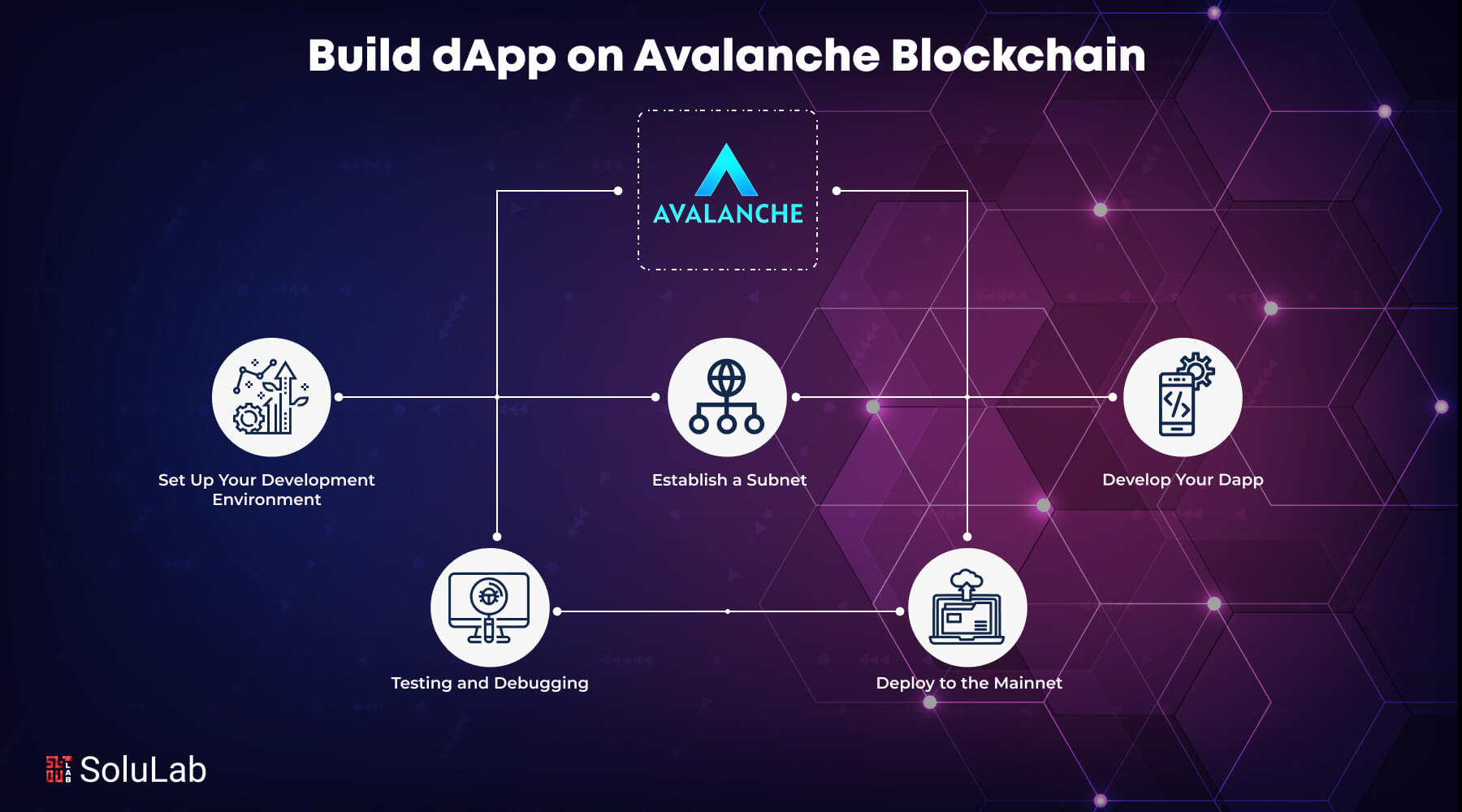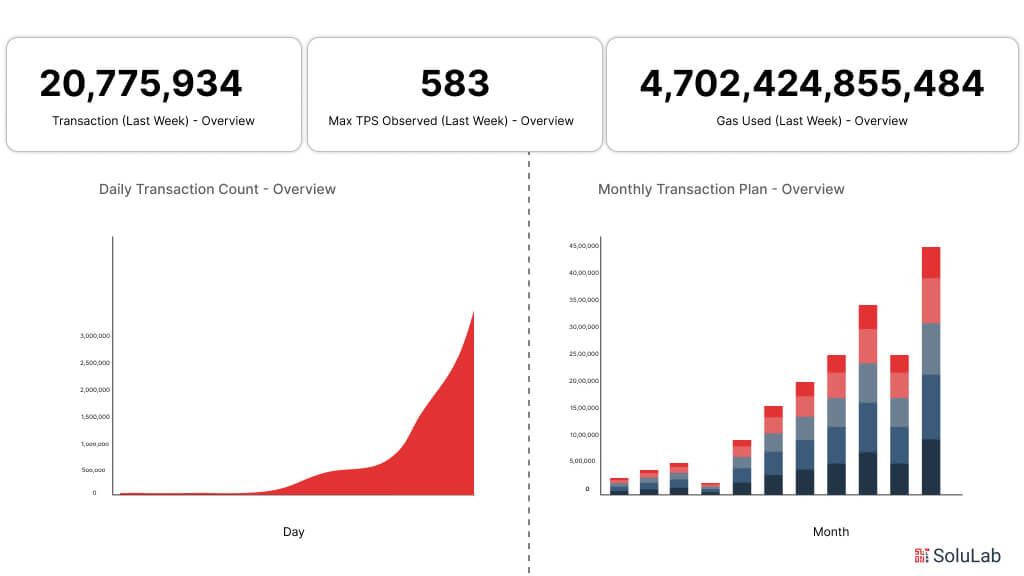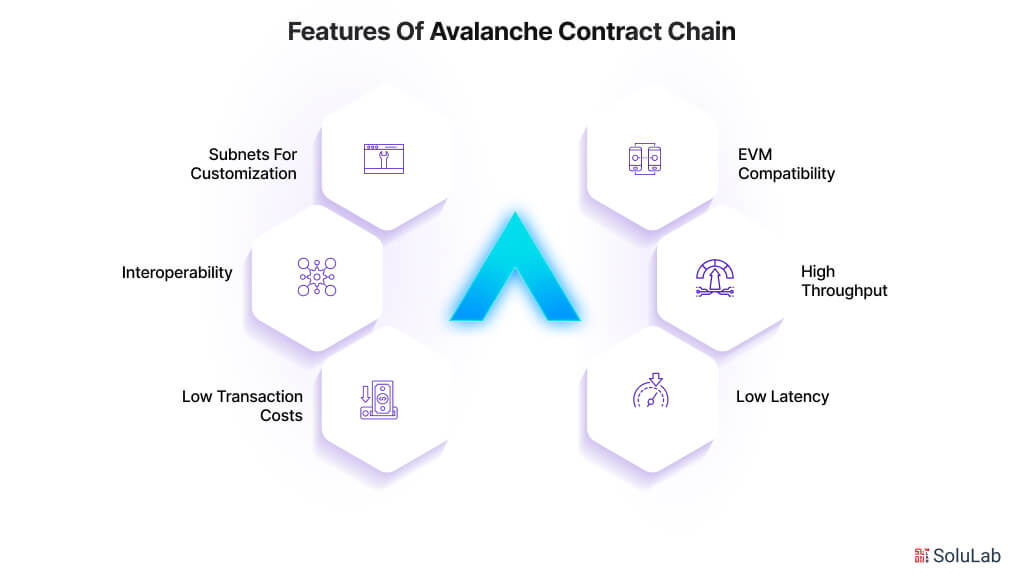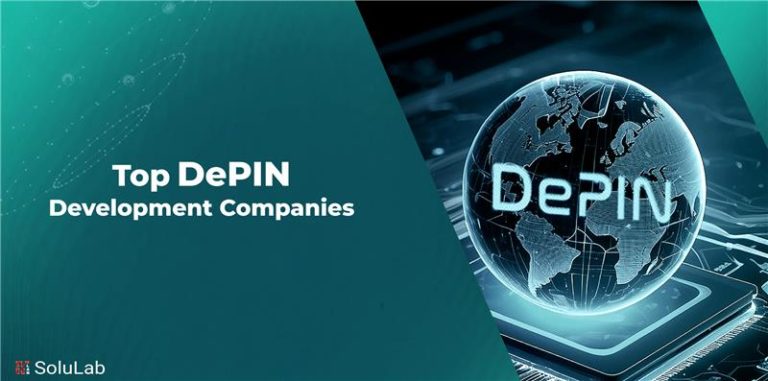
Within the Avalanche platform, developers can create and launch decentralized applications known as dApps, enabling them to leverage the Blockchain’s capabilities to unlock their earning potential. The platform has experienced significant growth, with statistics indicating that 20,952,045 transactions were processed, and this number continues to increase. As a result, more investors have adopted Avalanche Blockchain Dapp development to improve users’ financial experiences.
Avalanche stands out as a unique platform, often referred to as “Blockchains of Blockchains.” Unlike traditional Blockchain networks like Solana or Ethereum, which operate as single chains, Avalanche consists of three interconnected blockchains, each handling specific use cases. This interoperable, open-source, and scalable platform allows for seamless business Blockchain deployments and dApp development.
What is Avalanche?
Avalanche, a blockchain protocol, stands out in the realm of DeFi dApps and corporate blockchain deployments by prioritizing their needs. It sets itself apart as a scalable, interoperable, and open-source solution. Rather than being a single blockchain like Ethereum or Solana, Avalanche is aptly dubbed the “blockchain of blockchains.” Its unique architecture consists of three distinct blockchains, each with its specialized function, delivering a robust and adaptable platform.
The Avalanche ecosystem comprises three interconnected blockchains:
1. Exchange (X) Chain: Responsible for asset creation, management, and transaction processing.
2. Platform (P) Chain: Handles subnet creation, validator coordination, and network governance.
3. Contract (C) Chain: An instance of the Ethereum Virtual Machine (EVM), allowing for seamless integration and execution of smart contracts.
This insight focuses on the Contract (C) Chain, which is crucial for smart contract development on the Avalanche network and particularly relevant for developers building dApps on Avalanche. This chain is fundamental for building and deploying applications on the Avalanche blockchain.

The Architecture Of Avalanche Blockchain
The Avalanche Blockchain stands out as a unique platform, facilitating smooth deployments of business-focused blockchain solutions and the development of decentralized applications. This exploration will delve into “The Architecture of Avalanche Blockchain.” Understanding this framework is crucial for building robust applications and deploying them effectively on the Avalanche blockchain.
-
Avalanche Network
At the core of the Avalanche ecosystem, the Avalanche Network stands as a central hub, guiding and securing its operations. It serves as the backbone, ensuring seamless functioning and compatibility among all components within the Avalanche platform. Developing decentralized applications on Avalanche (Avalanche dApp development) is essential for harnessing these components to create a scalable, secure, and decentralized platform for building and deploying applications.
-
Subnets
Avalanche subnets are distinct blockchains designed for specific applications. Developers can leverage the Subnet Builder to craft and personalize these subnets. Among the available options are contract chains, and specialized subnets optimized for executing smart contracts. These contract chains excel in providing quick transactions and security, positioning them as optimal choices for constructing decentralized applications (dApps) and diverse blockchain development solutions.
-
Validator Nodes
In the Avalanche Network, validators are responsible for maintaining transaction validity, preserving network integrity, and facilitating consensus through proof of stake (PoS). They contribute to network security by staking AVAX tokens, earning rewards for their efforts. As part of their role, validators verify transactions before adding them to the blockchain. Factors influencing the selection of validators include the amount of staked AVAX, performance metrics, and uptime duration.
What is the Avalanche Contract (C) Chain?
The C-Chain acts as an Ethereum Virtual Machine (EVM) replica, enabling developers to effortlessly create smart contracts. Avalanche emphasizes that the C-Chain excels by providing superior throughput, increased speeds, rapid transaction confirmation time, and lower fees. This difference occurs from the C-Chain utilizing a Proof-of-Stake (PoS) consensus mechanism based on the Snowman Consensus Protocol, unlike Ethereum’s Proof-of-Work (PoW) consensus mechanism. Importantly, since the C-Chain runs the EVM, developers have unfettered access to the comprehensive Ethereum developer toolset.
Key Features of Avalanche Contract Chain

Within the Avalanche blockchain ecosystem, the C-Chain stands as an outstanding platform designed specifically for businesses. It provides the tools and infrastructure necessary for enterprises to construct and launch decentralized applications (dApps) that surpass conventional limitations. The C-Chain’s distinctive characteristics address the stringent demands of contemporary organizations seeking to leverage blockchain technology’s potential within their operations.
-
EVM Compatibility
The C-Chain’s seamless compatibility with the Ethereum Virtual Machine (EVM) gives developers access to a vast array of opportunities. Solidity, the predominant smart contract programming language, is natively supported on the C-Chain, enabling developers to utilize their existing knowledge and tools. This compatibility eliminates the requirement for additional learning or separate development environments, reducing the learning curve significantly. As a result, migrating existing Avalanche smart contract dApps from Ethereum to Avalanche becomes effortless, ensuring a smooth transition.
Within the C-Chain, developers have the advantage of utilizing the widely recognized Solidity programming language and its associated development tools. This seamless integration not only facilitates quick dApp creation and deployment but also provides developers with access to an extensive range of existing Ethereum resources. This includes comprehensive tutorials, detailed documentation, and a supportive community, all of which contribute to an accelerated and efficient development process.
-
High Throughput
With the Snowman Consensus Protocol, Avalanche’s C-Chain can process up to 4,500 transactions per second (TPS), upgrading enterprise applications’ ability to handle large transaction volumes efficiently.
The C-Chain’s high throughput is ideal for use cases requiring real-time tracking like supply chain management. It can also meet the demanding requirements of payment processing systems, ensuring seamless and instant transactions.
-
Low Latency
On the C-Chain, transaction finality is accomplished in seconds, offering real-time performance that is important for enterprise applications. The C-Chain’s low latency is especially advantageous for industries like financial services and decentralized exchanges, where time-sensitive decisions are made. It ensures that transactions are processed and executed rapidly, minimizing delays and enhancing operational efficiency.
Furthermore, the C-Chain’s low latency enables businesses to develop dApps that provide real-time updates, instant settlements, and seamless user experiences. This can revolutionize industries that require fast and reliable transactions, allowing for streamlined operations, improved decision-making, and enhanced customer satisfaction.
-
Low Transaction Costs
Compared to Ethereum’s fluctuating and potentially exorbitant gas fees, the C-Chain provides considerably lower transaction costs. This cost-effectiveness enables businesses to operate their dApps on Avalanche more affordably, minimizing operational expenses and promoting long-term sustainability.
Moreover, the C-Chain’s low fees open up new opportunities for micro-transactions and micro-services. These small or frequent payments would be impractical on networks with high fees.
-
Interoperability
The C-Chain facilitates seamless asset transfer between Avalanche and Ethereum, enabling developers to access the benefits of both blockchain ecosystems. This interoperability allows for the creation of innovative decentralized applications (dApps) with enhanced functionalities.
For example, dApps developed on the C-Chain can take advantage of the substantial liquidity of Ethereum’s decentralized finance (DeFi) ecosystem while simultaneously taking advantage of Avalanche’s scalability and cost-effectiveness. This facilitates the development of sophisticated dApps that combine the strengths of both platforms, unlocking new possibilities for decentralized applications.
-
Subnets for Customization
Within the C-Chain’s remarkable features lies the ability for businesses to create and operate customized blockchain networks known as subnets. These subnets are independent and sovereign blockchain networks designed to cater to specific requirements related to governance, compliance, and performance.
The flexibility offered by subnets allows businesses to craft and deploy decentralized applications (dApps) that seamlessly align with their unique requirements. For instance, a financial institution might leverage a subnet to ensure regulatory compliance, while a supply chain consortium could utilize a subnet to securely exchange sensitive data among its members.
Steps to Build dApps on Avalanche Blockchain
Avalanche Blockchain offers several compelling features that make it an attractive platform for enterprise dApp development. These include EVM compatibility, high throughput, low latency, low transaction costs, interoperability, and customizable subnets. To build dApps on Avalanche, follow these steps:
Step 1: Set Up Your Development Environment
-
Download and Install Avalanche Node Software:
To deploy decentralized applications (dApps) on Avalanche, start by visiting the official Avalanche website. On the downloads page, choose the appropriate installer for your operating system: Windows, macOS, or Linux. For Windows users, download the AvalancheGo executable file. After downloading, follow the setup process to complete the installation. For macOS and Linux users, download the provided installation scripts. To finish the installation process, adhere to the on-screen instructions.
-
Verify Installation:
To verify the successful installation of avalanche-go, launch your terminal or command prompt and input the command “avalanche-go“. Upon successful installation, a list of accessible commands and options will be displayed.
-
Generate a Wallet Address:
To interact with the Avalanche network securely, you’ll need a wallet address. You can use the official Avalanche Wallet or any other compatible wallet to create a wallet. Follow the instructions provided by the wallet provider to set up your wallet and generate a unique wallet address.
-
Purchase AVAX Tokens:
AVAX tokens are the native cryptocurrency of Avalanche and are used to pay transaction fees and stakes for validator nodes. To purchase AVAX tokens, you can use cryptocurrency exchanges such as Binance, Kraken, or Coinbase. Create an account on one of these exchanges and follow the instructions to buy AVAX tokens using your preferred payment method.
Step 2: Establish a Subnet to Enhance Your Dapp’s Functionality
-
Define Subnet Parameters:
Name: Choose a unique name for your subnet. The name should be descriptive of your Dapp’s functionality and easily identifiable; Purpose: Specify the purpose of your subnet. This could include the specific use case or application your Dapp will serve.; Rules: Define the permissions and restrictions for validators on your subnet. These rules determine who can participate as a validator and the actions they can perform.
-
Stake AVAX:
Determine the minimum amount of AVAX required to create your subnet. This amount depends on the subnet’s configuration and the number of validators you plan to have. Stake the required amount of AVAX to the subnet creation contract. This AVAX will be used to secure the subnet and reward validators for their participation.
-
Select Validators:
Choose validators to secure and operate your subnet. Validators are responsible for validating transactions, maintaining the subnet’s security, and ensuring its smooth functioning. You can either run your own validator nodes or delegate your stake to existing validators. Running your own nodes provides greater control and flexibility while delegating your stake allows you to participate in the subnet without managing infrastructure.
-
Receive Subnet ID:
Once your subnet is created, you will receive a unique subnet ID. This ID identifies your subnet on the Avalanche network and is used to distinguish it from other subnets. The subnet ID is essential for configuring your Dapp to interact with the subnet and for managing its resources.
Step 3: Develop Your Dapp
-
Choose a Programming Language:
Avalanche supports various programming languages, including Solidity, Go, Rust, and Python. Research each language’s strengths and weaknesses to determine which one aligns best with your Dapp’s requirements. Consider factors like the language’s popularity, tool support, and the availability of resources and developers. If you’re familiar with Solidity, you can leverage its widespread adoption and large community. If you prefer a language known for its performance, Rust might be a suitable choice. For beginners, Python and Go are appealing alternatives due to their simplicity, straightforwardness, and ease of use.
-
Create Smart Contracts:
Smart contracts are the foundational elements of your Dapp, defining its logic and rules. Use a text editor or an integrated development environment (IDE) to write your smart contracts. Familiarize yourself with the syntax and semantics of the chosen programming language. Clearly define the functions, variables, and data structures used in your smart contracts. Test your smart contracts thoroughly to ensure they behave as expected under various conditions.
-
Deploy Smart Contracts:
Use the Avalanche SDK to deploy your smart contracts to a subnet. Avalanche DeFi dApp developers can benefit from a subnet, which is a private network within the Avalanche network, providing a dedicated environment for your Dapp. Follow the documentation and tutorials provided by Ava Labs to set up and manage your subnet. Use the Avalanche CLI or web interface to interact with your smart contracts and perform transactions.
-
Develop a User Interface:
The user interface is the part of your Dapp that users interact with. Choose a front-end framework that suits your needs and preferences. Popular options include React, Angular, and Vue.js, known for their rich features and ease of use. Avalanche dApp development services can assist in creating a user-friendly and intuitive interface that aligns with your Dapp’s functionality. Incorporate interactive elements, such as buttons, forms, and charts, to enhance the user experience. Implement responsive design principles to ensure your Dapp works well on different devices and screen sizes.
Step 4: Testing and Debugging
-
Leverage Avalanche’s Testnets for Risk-Free Testing:
Utilize Avalanche’s test networks to test your Dapp without jeopardizing real funds. These testnets offer a simulated environment with AVAX tokens dedicated to testing purposes. Avalanche offers multiple testnets, each with its unique features and benefits. Select the testnet that best aligns with your testing requirements. Take advantage of Avalanche’s vibrant community of developers and contributors who often share tips, resources, and insights related to testing on the testnets.
-
Identify and Resolve Smart Contract Issues:
Employ debugging tools and techniques to identify and rectify any problems within your smart contracts. Avalanche blockchain dApps benefit from tools such as the Avalanche CLI and the Avalanche Web3 Console to assist in this process. Understand the concept of gas optimization and how it can impact the performance and cost of your smart contracts.
-
Measure Performance and Scalability:
Evaluate your Dapp’s performance and scalability to ensure it meets your expectations. Use tools like Avalanche Bench and Apache JMeter to measure these aspects under varying loads. Understand the relationship between transaction volume, block size, and network congestion. Identify bottlenecks in your Dapp’s architecture and implement optimizations to improve performance. Consider the impact of smart contract complexity on scalability. Optimize your smart contracts for efficiency to handle increased transaction volume without compromising security.
Step 5: Deploy to the Mainnet
-
Prepare Your Dapp for Mainnet Deployment:
Ensure your smart contracts are audited by a reputable security firm to identify and fix any vulnerabilities. Avalanche dApp marketplace developers should implement gas optimization techniques, such as batching transactions and using efficient algorithms, to minimize transaction fees. Update your Dapp’s documentation and user interface to reflect the transition to the mainnet. Include clear instructions on how users can interact with your Dapp on the mainnet. Test your Dapp extensively on a staging environment that closely resembles the mainnet. This will help identify and resolve any potential issues before deploying to the mainnet.
-
Transfer Assets to the Mainnet:
Choose a reputable bridge or cross-chain solution that is secure and has a proven track record. Carefully review the bridge’s documentation and follow the instructions to transfer your smart contracts and assets from the testnet to the mainnet. Double-check that all assets and contract addresses are correct before initiating the transfer. Consider using a multi-sig wallet for added security. Monitor the transfer process closely and ensure that all assets are successfully transferred to the mainnet.
-
Update Dapp Configuration:
Update your Dapp’s configuration files to point to the mainnet nodes and smart contract addresses. Ensure that your Dapp connects to the correct endpoints and networks. Test your Dapp thoroughly on the mainnet to verify that it functions as expected. Pay special attention to gas costs and transaction speeds. Monitor your Dapp’s performance and usage metrics to identify any areas for improvement.
-
Market Your Dapp:
Develop a comprehensive marketing strategy that targets your ideal users and aligns with your overall business goals. Create high-quality content, such as blog posts, tutorials, videos, and infographics, to educate potential users about the benefits and features of your Dapp. Utilize social media platforms, online forums, and developer communities to build a community around your Dapp and engage with potential users. To increase the visibility and trustworthiness of your Dapp, partner with influencers and thought leaders in the blockchain community. Additionally, attend industry conferences and events to establish connections with potential users and partners, expanding your network within the blockchain ecosystem.
-
Monitor and Maintain Your Dapp:
Continuously monitor your Dapp’s performance and security using analytics tools and monitoring services. Implement robust security measures, such as access control, encryption, and regular security audits, to protect your Dapp from attacks. How to build dApps on Avalanche involves not only development but also ensuring that you respond to any issues or vulnerabilities reported by users or security researchers. Regularly update your Dapp to incorporate new features, fix bugs, and address security vulnerabilities. Maintain open communication with your community to keep users informed about updates and improvements. Consider establishing a support channel where users can ask questions and report issues.
Conclusion
Building a decentralized application (dApp) on the Avalanche blockchain opens up numerous opportunities for developers, providing them with a scalable, efficient, and highly secure platform to create solutions. By leveraging the Avalanche network’s low fees, high throughput, and customizable subnets, developers can ensure that their dApp meets the needs of a modern, decentralized economy. The process, though technical, is made easier with the support of blockchain development companies that provide expert guidance throughout each phase of development. Additionally, utilizing DePIN Blockchain as a Service further simplifies infrastructure management, allowing creators to focus on innovation without worrying about the backend setup.
We recently published a case study on OBORTECH, where SoluLab helped the company integrate a Blockchain as a Service platform for its SmartHub. OBORTECH’s SmartHub, which seamlessly integrates blockchain with IoT devices, provides real-time data collection and interaction, ensuring transparency and data security for supply chain management. SoluLab developed key features like a staking platform for OBOT tokens and a cryptocurrency payment gateway, both of which enhanced user engagement and streamlined financial transactions. These solutions demonstrate how partnering with an experienced company like SoluLab can enable businesses to overcome complex blockchain challenges, including interoperability and scalability, while also simplifying user interfaces for non-technical users.
SoluLab, one of the leading blockchain development companies, specializes in providing Blockchain as a Service and custom dApp solutions for various industries. Whether you’re looking to launch a dApp on the Avalanche blockchain or explore DePIN Blockchain as a Service, SoluLab can help you accelerate your project’s success. If you’re ready to scale your blockchain solution, Hire a Blockchain Developer from SoluLab and start building the future today.
FAQs
1. What are the key steps to build dApps on Avalanche?
To build dApps on Avalanche, developers follow steps like setting up a development environment, coding the smart contracts using Solidity, deploying them on the Avalanche C-Chain, and creating a user interface that interacts with the smart contracts.
2. Why is Avalanche a good choice for dApp development?
Avalanche dApp development offers high throughput, low transaction fees, and customizable subnets. These features make it ideal for building scalable and fast decentralized applications.
3. How can I deploy dApps on Avalanche?
Developers can deploy dApps on Avalanche using the C-Chain, which supports Ethereum-compatible smart contracts. Tools like Remix and Avalanche’s APIs simplify the deployment process for developers.
4. What services do Avalanche dApp development companies offer?
Avalanche dApp development services include smart contract development, UI/UX design, integration with DeFi protocols, security audits, and dApp deployment on Avalanche’s blockchain network.
5. What industries can benefit from Avalanche blockchain dApps?
Avalanche blockchain dApps are used across finance, supply chain, gaming, and healthcare industries, especially due to the network’s speed, scalability, and low costs.
6. What are Avalanche DeFi dApps, and why are they popular?
Avalanche DeFi dApps are decentralized applications in the finance sector that enable lending, borrowing, staking, and trading without intermediaries. They are popular because of Avalanche’s low fees and high speed, making financial transactions faster and cheaper.
7. How does the Avalanche dApp marketplace function?
The Avalanche dApp marketplace allows developers and users to interact with various dApps built on the network. It acts as a hub for decentralized applications across various sectors like DeFi, NFTs, and more.






